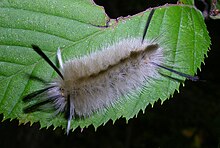Halysidota tessellaris
| Halysidota tessellaris | |
|---|---|

| |
| Scientific classification | |
| Domain: | Eukaryota |
| Kingdom: | Animalia |
| Phylum: | Arthropoda |
| Class: | Insecta |
| Order: | Lepidoptera |
| Superfamily: | Noctuoidea |
| Family: | Erebidae |
| Subfamily: | Arctiinae |
| Genus: | Halysidota |
| Species: | H. tessellaris
|
| Binomial name | |
| Halysidota tessellaris (J. E. Smith, 1797)
| |
| Synonyms | |
| |

Halysidota tessellaris, also called the pale tiger moth, banded tussock moth, and tessellated halisidota, is in the family
Range
This moth is found in North America from southern Canada south through Texas and central Florida.[4]
Life cycle
One generation per year occurs in the north, and two or more occur in the south.[4]
Egg
Eggs are laid in masses on the undersides of leaves.[5]

Larva
Caterpillars are covered with long
Pupa
Pupae overwinter in gray cocoons laced with larval hairs.[4]
Adults
Wings are light brown. Forewings have bands of beige edged in black. The body is 'hairy' and yellow. The thorax has blue-green lines on its uppersides. Adults are attracted to decaying plants with pyrrolizidine alkaloids.[6] They regurgitate on them, then drink the fluids, and acquire defensive chemicals.

Food plants
Larvae are known to feed on some species of alder, ash, birch, blueberry, chestnut, elm, grape, hackberry, hazel, oak, walnut, willow, and many others.[4] No serious injury to trees has been reported for this late-season feeder.[5]
References
- ^ Hodges, R.W (1983). "Halysidota tessellaris - (J.E. Smith, 1797) Banded Tussock Moth". NatureServe. Retrieved 17 September 2019.
- S2CID 33676051.
- ISSN 0024-4066.
- ^ ISBN 978-1-4008-3414-3.
- ^ OCLC 10305246.
- S2CID 12407539.
External links
- "Halysidota tessellaris". Moths of Maryland.
- Bartlett, Troy (September 2, 2019). "Species Halysidota tessellaris - Banded Tussock Moth - Hodges#8203". BugGuide. Retrieved September 17, 2019.

